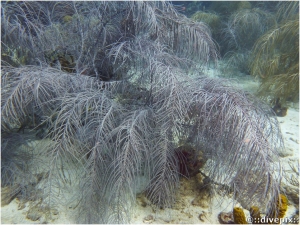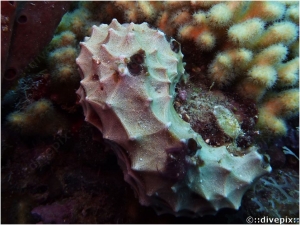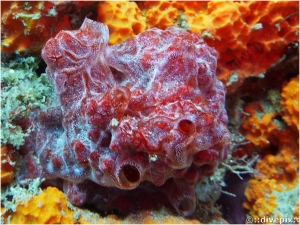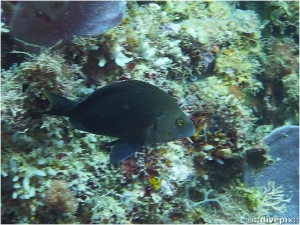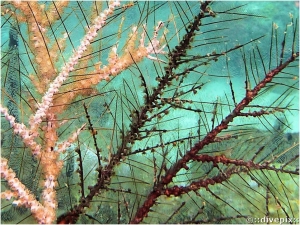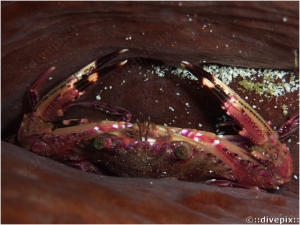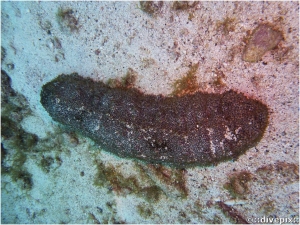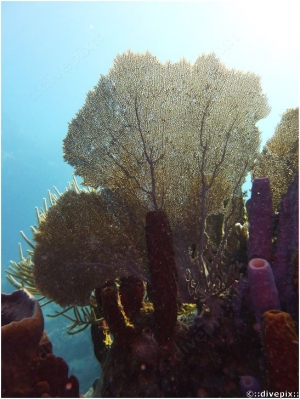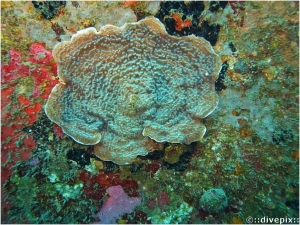




Eric H. Biass
Monday, 06 July 2015 11:55
Sea Plumes spp.
| Aspect: | Greyish bush of branches opening up like a firework, each carrying pinnately arranged sub-branches that bear the polyps. These extend in opposite directions on either side of the sub-branches. |
| Population: | Common. |
| Notable feature: | There are scores of Sea Plumes varieties that are difficult to identify with certainty, unlike the Slimy Sea Plumes (q.v.) that stand out due to a tacky substance their branches exude. |
| Environment: | Generally on rock or stone in sandy bottom areas gently swept by currents, in shallow and semi-deep waters. |
| Behaviour: | Polyps often extend in daytime, but touching one will cause almost all others to retract instantaneously. |
Published in
Octocorals
Tagged under
Saturday, 27 June 2015 19:53
Knobby Sea Rod spp.
| Aspect: |
Whitish (generally) multiple branch structure that tends to develop in a single plane Compared with other sea rod octocorals, the Knobby Sea Rod is distinguished by its relatively slender branches in relation to their overall diameter when all polyps are extended. Thus called because of the knobs that remain on the branch surface once the polyps have retracted. This is the only visual feature that distinguishes it from the otherwise very similar Warty Sea Rod (q.v.) where retracted polyps look like creviced lumps (hence the warty association). |
| Population: | Common. |
| Notable feature: | White, light yellow or light tan body, Tentacles are light grey to white and emerge from long "gaitered" stems. |
| Environment: | Like most Sea Rods, generally grows on even rocky or sandy substrates, starting from depths of 5 metres, down to 30 metres. |
| Behaviour: | - |
Published in
Octocorals
Tagged under
Monday, 18 May 2015 19:46
Stinker Sponge
| Aspect: | Light grey structure of pyramidal structures linked by a complex latice. |
| Population: | Occasional. |
| Notable feature: | Owes its vernacular name to the unpleasant smell it produces when taken out of the water.. |
| Environment: | Shallow waters. |
| Behaviour: | - |
Published in
Sponges
Tagged under
Monday, 18 May 2015 19:10
Red Encrusting Sponge
| Aspect: | A bright red or pink spongy mass with sparse white surface areas boasting randomly scattered excurrent chimneys from which radiate vein-like surface canals. Unlike other similar-looking encrusting sponges, these canals are darker than the body of the mass. |
| Population: | Occasional. |
| Notable feature: | CAUTION: There is very little detailed literature on the species, and the little there is proves inconsistent as some sources call it Manonchora barbadensis while others designate it Monanchora arbuscula. It now appears that only Monanchora arbuscula is the accepted designation. |
| Environment: | Protected and recessed areas (which may explain rare visibility). |
| Behaviour: | - |
Published in
Sponges
Tagged under
Sunday, 17 May 2015 20:02
Black Hamlet
| Aspect: | Uniformly dark grey/dark blue over typical hamlet outline, with steep sloping head. |
| Population: | Rare. |
| Notable feature: | Almond-shaped eyes typical of serranidae. |
| Environment: | Shallow waters, stays close to the bottom in areas offering quick shelter. |
| Behaviour: | Shy. |
Published in
Hamlets
Tagged under
Friday, 15 May 2015 19:34
Hydroid Zoanthid
| Aspect: | Colonies encrust main and secondary branches of Feather Bush Hydroids (q.v.), to the point of completely "sleeving" them. When not deployed, polyps form a lump of the same colour as the encrusting base. |
| Population: | As common as their bearers. |
| Notable feature: | As some of the photographs herewith show, these zoanthids can vary in colour from pale yellow through orange and maroon to brown. The polyps are of the same colour tone as their encrusting base. |
| Environment: | Same as Feather Bush Hydroid. |
| Behaviour: | Polyps retract when disturbed. |
Published in
Zoanthids
Tagged under
Monday, 11 May 2015 20:01
Black Point Sculling Crab
| Aspect: | Dark red and brown carapace; green eyes. |
| Population: | Occasional (but also difficult to spot). |
| Notable feature: | Has near-black and white pincers; paddled rear legs (like Ocellate Swimming Crab, q.v.) that enables it to swim away fast. |
| Environment: | Recesses and inside vase or barrel sponges. |
| Behaviour: | Must be approached causiously or will swim away. |
Published in
Crabs
Tagged under
Friday, 01 May 2015 18:57
Harlequin Sea Cucumber
| Aspect: | Looks like a very large, maroon, unattractive rubbery cucumber, densely covered with darker thin podia. |
| Population: | Common. |
| Notable feature: | - |
| Environment: | Sandy relatively shallow waters. |
| Behaviour: | - |
Published in
Echinoderms
Tagged under
Sunday, 19 April 2015 13:13
Venus Sea Fan
| Aspect: | A delicate thin, single-plane lattice that spreads from several main branches. Very similar in shape and colour (generally tan or light green, often with pink/purple root and main branches) to other sea fans. |
| Population: | Common. |
| Notable feature: | The only way of visually distiguishing the Venus Sea Fan from the similar Common Sea Fan (q.v.) is to take a close-up view of its structure: if the thin branches that constitute the lattice (and which houses the coral polyps) are rounded or domed on either side of the main plane, it most likely is a Venus Sea Fan. |
| Environment: | From shallow waters all the way down to 30 metres, but specimens have been seen as deep as 50 metres. Often oriented against the current for better water sifting action. |
| Behaviour: | Easily break under careless diver fin action, reason why shallow water specimens are often damaged. |
Published in
Octocorals
Tagged under
Wednesday, 15 April 2015 19:07
Sunray Lettuce Coral
Published in
Stony corals
Tagged under



